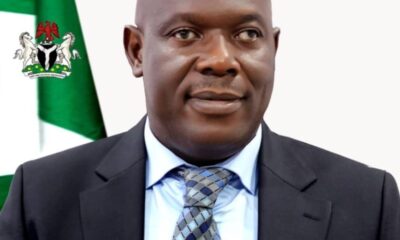Opinion
Planning The National Economy
As observed by W. Arthur Lewis: “Making development plans is the most popular activity of governmentof underdeveloped countries since the war, and is also nearly their biggest failure.” Nigeria’s experience is a case in point. With over six decades of planning its economy, the pertinent fact remains that the country has not been able to extricate itself from the vicious clutches of underdevelopment. Worse still, none of the development planning objectives has been achieved. Why? The reasons are numerous.
First, it is perceived by some scholars that the failure of development plans in Nigeria to yield the desired result is a necessary outcome of the incorporation of the country into the global capitalist orbit, and the notion that economic development is the same thing as westernization.
The scholars including C. Ake, P . E. Ollawa, Dos Santos, Chinweizu, and A.G. Frank argue that any meaningful analysis, appreciation, or understanding of underdevelopment must begin with the understanding of the nature, pattern and level of capital penetration, resource exploitation, mechanism of surplus expropriation, pattern of international relations, and the general effects of these on the policies pursued by the country.
Second, the plans are more often than not aggregations of incompatible projects and policies and not strategies for development. In the NEEDS document, it is stated: “The overall strategy is to diversify the productive base of the economy away from oil and to foster market-oriented, private sector-driven economic development with strong local participation.”
From the NEEDS document, it is not difficult to see why, over the years, what have passed as strategies for the pursuance of development plan objectives for the country include expansion and diversification of agricultural export commodities, import substitution, export, promotion, indigenisation, integrated rural development, structural adjustment programmes, commercialisation and privatisation programmes.
It is apparent that with these strategies and policies, the productive base of the economy has remained undiversified.
In the pre-civil war period, export of agricultural produce was the engine of growth of the country’s economy. But in the post-civil war decades, petroleum became increasingly important directly for both the balance of payments and government revenue, and indirectly for income propagation. The emphasis and high hopes placed on petroleum production especially during the Second National Development Plan (1970 – 75) resulted in the neglect of the agricultural sector; and the result was that the level of food production in the country barely kept pace with the population growth. Unfortunately, the subsequent plans and policies have not succeeded in reversing the trend.
Thirdly, development plan failure in Nigeria has also been attributed to inefficient, ineffective and inappropriate administrative machinery for planning.
From the “Ten-Year Plan of Development and Welfare for Nigeria” prepared under the British colonial administration, it was quite clear that the colonial administrative machinery was limited in its objectives of maintenance of law and order and of opening up the colonial economy to serve the needs of the metropolitan government. Improbably, the country’s achievement of independence in 1960, has not transformed the public service into development-oriented machinery, without which development planning would be a farce.
Today, despite the efforts to improve the processes and machinery of planning in the country, there is no indication that members of the public are constantly being consulted or made to feel part of the development process. It is indeed doubtful if some top officials of ministries are really aware of or familiar with the projects of their ministries.
The fourth index of the failure of development planning in Nigeria is that nobody takes the plans seriously after the initial fanfare with which they are published. This is understandable.
The large figures, the billions of naira to be spent on innumerable projects and the projected high rates of growth, as well as the high hopes generally raised, give an indication that the plans are mere political propaganda and pure fantasy. So what you find is that the plans are put aside and often forgotten on the shelves soon after they are made. Supposedly, the officials who made the plans hardly consult them for government actions or inactions.
The final index is the primacy of politics in the public policy and decision-making behaviours of the country’s leaders.
In the language of P. E. Olawa, “The primacy of politics exists in the process of policy and decision-making when political considerations out-weigh rational technical questions of selecting alternatives which have the greatest probability of effecting the most efficient allocation of scarce resources.”
Primacy of politics approach has three basic features: decision adhocism, preference of immediate short-term goals to long term ones, and making of major policy decisions without considering their repercussions on long-term planning.
It will be interesting to go into the exposition of these features but that will take us too far beyond the concerns of this piece. But suffice it to say that these features have continued to manifest in the political expediency and spontaneity with which Nigerian leaders make promises and far-reaching decisions and site projects.
Yes, I write this piece with the perception that planning is the first responsibility of a leader or manager. So, as Presidnet Goodluck Ebele Jonathan settles down to his challenging state duties, his first task should be to address these perennial problems of plan formulation and implementation highlighted above, and then come up with distinctive, bold, and boom ideas that will turn planning in Nigeria into a propelling force that is capable of uplifting the· country to greater heights.
Some of the requirements for a successful development plan are inclusive, efficient, and effective planning machinery, valid statistical data, physical and financial balances, inspiring, realistic and mutually compatible and flexible objectives, as well as effective mobilisation of resources. Others include incorrupt and efficient personnel and administration of government, proper development policy, a firm educational base, national conciousness and public cooperation.
The future is bright for the Nigerian nation, but it is imperative that the country should, with a collective sense of purpose, be willing to plan and work for it’s ecoomic, social, and political development and greatness.
Opinion
Ndifon’s Verdict and University Power Reform

Opinion
As Nigeria’s Insecurity Rings Alarm

Opinion
The Girl Who Didn’t Dance
-

 Featured1 day ago
Featured1 day agoOil & Gas: Rivers Remains The Best Investment Destination – Fubara
-

 Nation2 days ago
Nation2 days agoOgoni Power Project: HYPREP Moves To Boost Capacity Of Personnel
-
Nation2 days ago
Hausa Community Lauds Council Boss Over Free Medical Outreach
-
Nation2 days ago
Association Hails Rivers LG Chairmen, Urges Expansion Of Dev Projects
-
Nation2 days ago
Film Festival: Don, Others Urge Govt To Partner RIFF
-
Rivers2 days ago
UNIPORT Moves To Tackle Insecurity … Inducts Security Experts
-

 News2 days ago
News2 days agoNDLEA Arrests Two, Intercepts Illicit Drugs Packaged As Christmas Cookies
-
Nation2 days ago
MOSIEND Calls For RSG, NDDC, Stakeholders’ Intervention In Obolo Nation

